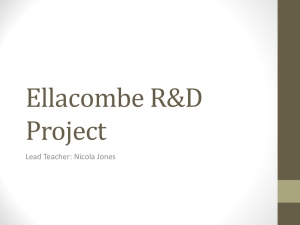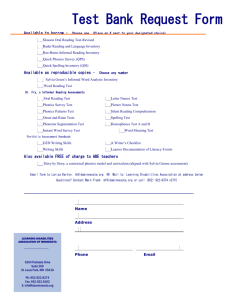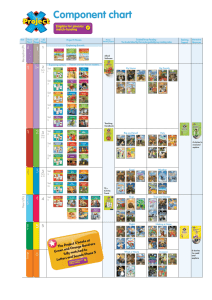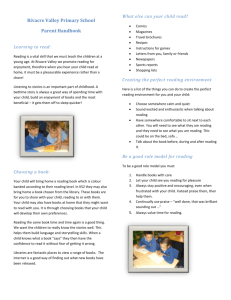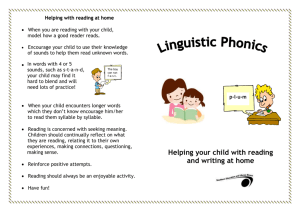PowerPoint format - University of Utah Reading Clinic
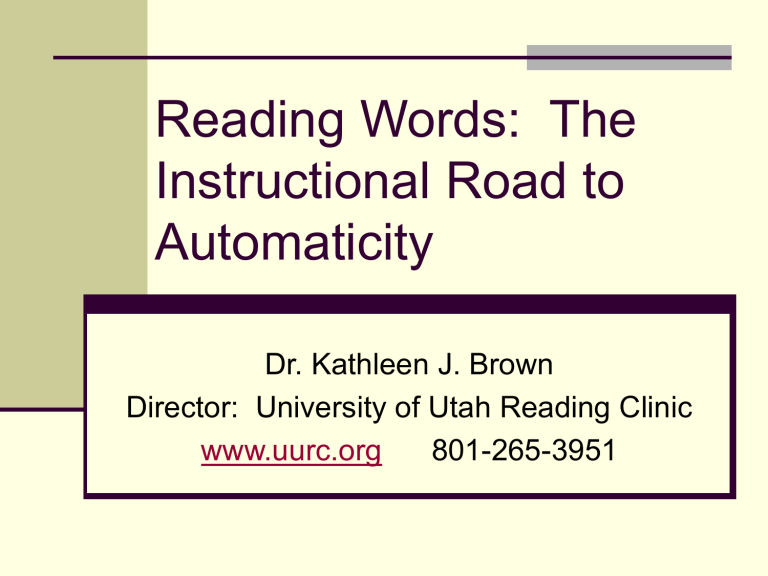
Reading Words: The
Instructional Road to
Automaticity
Dr. Kathleen J. Brown
Director: University of Utah Reading Clinic www.uurc.org
801-265-3951
Expert Reading=Word Rec X Comp
Word Recognition is
Automatic
Comprehension is both
Automatic & Strategic
accurate
fast
effortless
accurate, fast, effortless
know how to troubleshoot
flexible
persistent
(Adams, 1990; Rayner, Foorman, Perfetti, Pesetsky, & Seidenberg, 2001)
Novice Reading=Word Rec X Comp
Word Recognition is
Necessarily Strategic
often inaccurate
slow
effortful
Comprehension is both
Automatic & Strategic
accurate, fast, effortless
know how to troubleshoot
flexible
persistent
(Adams, 1990; Rayner, Foorman, Perfetti, Pesetsky, & Seidenberg, 2001)
Novice Reading=Word Rec X Comp
Word Recognition is
Necessarily Strategic:
Word Recognition Must
Become Automatic.
often inaccurate
slow
effortful
Most children need explicit, systematic instruction phonics & practice in text.
Some need basic word rec. intervention!
A few need intensive word rec. intervention!
Age is Almost Irrelevant…
Phonics & Text Should
Target the Child’s
Instructional Level & Move as Mastery is Achieved!!!!
Identify Child’s Instructional Level:
Text That Can Be Read With:
at least 93% accuracy, and rate of:
primer (mid G1)- at least 30 wpm
end G1 - at least 40 wpm mid G2 – at least 60 wpm
end G2 - at least 80 wpm
mid G3 - at least 80 wpm end G3 – at least 110 wpm end G4 – at least 120 wpm
Three Questions to Ask Every
Day about Every Child:
1. Right now, what is already “in this child’s head” for these words:
- cup?
- spurt?
- skullduggery?
a.k.a. representation in memory
2. Where should I go next with phonics to extend what is “in the head?”
3. What type of text is best for extending what is
“in the head?”
IMPLICATION:
Phonics and Text Type should change over the course of development to:
1. reinforce what is already known and
2. help the child progress as quickly as possible
Know the “Race Course” of
Word Recognition Development
STARTING LINE
Learning About Print
pre-alphabetic to partial alphabetic reader
K students
Breaking the Code (a.k.a. Glued to Print) ****
partial alphabetic to full alphabetic reader
early to midG1
(Ehri, 2005; Stanovich, 2000)
What Needs To Be In Place to
“Break the Code?”
Letter-sound correspondences (e.g., c = /k/)
Concept of word (1-to-1 voice to print match)
Identify and isolate first consonant phoneme in words
Short vowel sounds
What Kind of Phonics? Text?
Phonics:
- explicitly teach blending a.k.a. “sound it out” with 3 letter, 1 syllable words with 1 short vowel
- drill vowel sound cards
- speed check for accuracy & fluency (no<35 in
1min; no>2 errors)
Text Type: interesting texts with repetition of easy high frequency words; most other words are decodable
(e.g., A Present for Baby Bear , Bob Books )
Text Levels: 4-8 (approximately) = oct-dec G1
Phonics: Short Vowels – Closed
Syllables cat win mom
Phonics: Short Vowels – Closed
Syllables cat win mom pig job lap
Phonics: Short Vowels – Closed
Syllables cat lap win pig mom job hop rock van hit flat chip
High Freq. Words for G1 Level
Readers (beginners & strugglers)
get a list (e.g., Dolch) start with easiest & gradually complex use “flash” presentation
read off the deck
sort into 2 piles: automatic vs. wrong or >3 second hesitation redo “trouble” pile
when deck n=25, retire 15 and build up again
for G1 readers, do not build “torture decks”
every “trouble” word needs 5 fairly solid words
Three Questions to Ask Every
Day about Every Child:
1. Right now, what is already “in this child’s head” for these words:
- cup?
- spurt?
- skullduggery?
a.k.a. representation in memory
2. Where should I go next with phonics to extend what is “in the head?”
3. What type of text is best for extending what is
“in the head?”
Know the “Race Course” of
Word Recognition Development
STARTING LINE
Learning About Print
pre-alphabetic to partial alphabetic reader
K students
Breaking the Code (a.k.a. Glued to Print) ****
partial alphabetic to full alphabetic reader
early to midG1
Going for Fluency ****
full alphabetic to early consolidated reader
endG1 – endG2
PARTIAL FINISH LINE & onward…
What Needs To Be In Place to “Go for Fluency?”
everything in the “learning about print” phase
automaticity for 50-75 high frequency words
(e.g., the, said)
ability to quickly blend unfamiliar 3-5 letter 1 syllable words
What Kind of Phonics? Text?
Phonics:
- explicitly teach chunking strategy with 4 and 5 letter 1 syllable words with most common phonograms (e.g., turn spurt)
- augment & drill vowel sound cards
- speed check for accuracy & fluency (no<35 in
1min; no>2 errors)
Text Type: interesting “easy reader” texts that gradually increase in difficulty (e.g., Sammy the
Seal
Frog and Toad Nate the Great )
Text Levels: 8-12/16 (approximately) = jan-june G1
Phonics: Vowel Patterns – Syllable
Types cat lap van lake gate barn park tail rain paid sharp flame brain flat
High Frequency Words for G2+
Level Struggling Readers
get a list (e.g., Dolch)
gradually build a word deck from oral reading errors & list use “flash” presentation
read off the deck
sort into 2 piles: automatic vs. wrong or >1.5 second hesitation redo “trouble” pile
when deck n=25, retire some and add as needed
Irregular & High Frequency Words
For persistent “trouble” words, try:
Letter-Sound-Trouble Analysis
Make-n-Break
2,2,&2
For persistent “trouble” words, child must:
Say word aloud as often as possible
Ask “What word?”
Spell word aloud
Physical manipulatives can help!
Visualization can help!
Three Questions to Ask Every
Day about Every Child:
1. Right now, what is already “in this child’s head” for these words:
- cup?
- spurt?
- skullduggery?
a.k.a. representation in memory
2. Where should I go next with phonics to extend what is “in the head?”
3. What type of text is best for extending what is
“in the head?”
What Kind of Phonics? Text?
Phonics:
- explicitly teach syllable types, division, & morphemic knowledge (e.g., skullduggery, disruptive) a.k.a. representation in memory
Text Type: interesting texts with some control that gradually increase in difficulty (e.g., Marvin Redpost
Magic Tree House )
Text Levels: 18 and up = end G1 and on
Types of Syllables: Driven by
Orthography & Morphology
cup, branch Closed syllables
the, of, who, enough High Frequency &
Irregular
lake, barn, tail Vowel patterns
hopped, pretest, provoke, incandescent
Words with affixes and polysyllabic words
(Henry, 1990; Moats, 2000; Morris, 2005; UURC, 2006;
Wilson, 2006)
“Breaking Up” Big Words: Syllable
Types & Morphemes velvet hobo incandescent confirmatory decline rumple boisterous disruptive
Three Questions to Ask Every
Day about Every Child:
1. Right now, what is already “in this child’s head” for these words (e.g., cup, burn, skullduggery)?
a.k.a. representation in memory
2. Where should I go next with phonics to extend current representations?
3. What type of text is best practice for extending current representations?
Resources for Educators & Parents
Discover Intensive Phonics
Wilson Language/Fundations
LETRS (Language Essentials for Teachers of
Reading & Spelling)
Texts by Louisa Moats, Marcia Henry, Isabel
Beck, Words Their Way group
University of Utah Reading Clinic (UURC)
801-265-3951 or www.uurc.org


